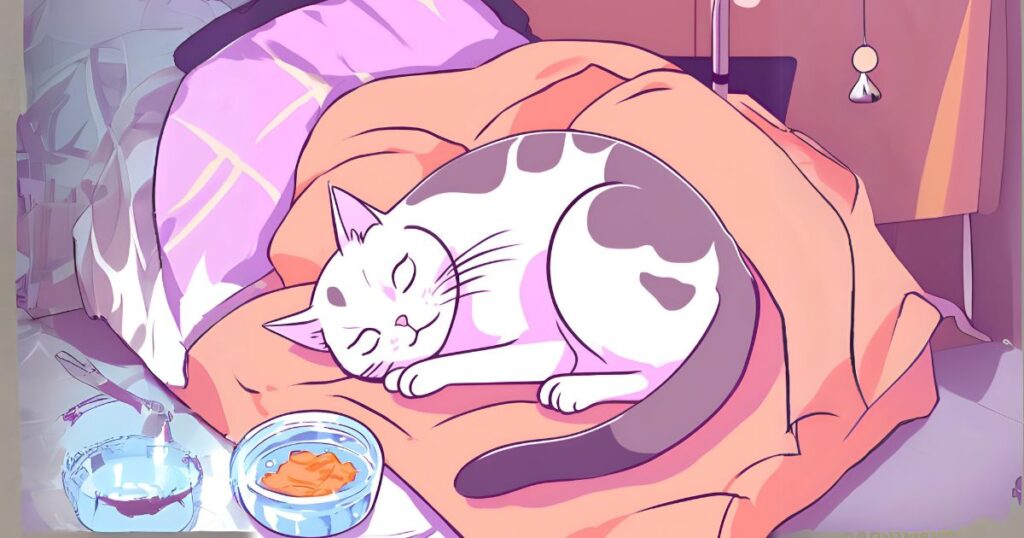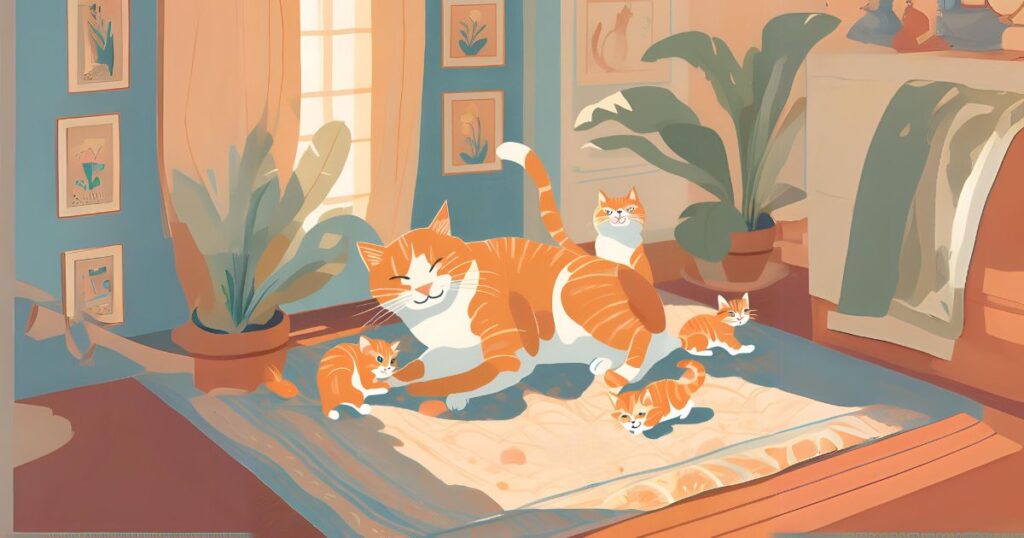Let’s dive into the amazing journey of your feline’s motherhood together, from recognizing the signs of her blossoming pregnancy to all the love and care she needs from those adorable baby bumps to the big day and beyond!
When a cat’s expecting, it’s a whole new chapter that calls for a bit of know-how and some careful planning. Knowing first signs of a new life within her, the ins and outs of labor, and post-birth care is crucial.
Joining her from the very beginning of her journey of motherhood all the way into her last weeks of nesting behavior, this article will cover the fundamentals of prenatal care.

Recognizing the Signs of Pregnancy
One way to get ready for the changes that are bound to come is to learn how to detect pregnancy in your cat. Indications to observe are:
Pink nipples: If your cat is expecting a baby, you may notice that her nipples may swell and take on a rosy hue around the third week of pregnancy. This is called “pinking up”.
Increased appetite: As the days roll on, a soon-to-be mama cat finds herself becoming hungrier, as her body is working hard to feed her offspring in her belly.
Abdominal swelling: Her tummy will start to enlarge around the fourth week of pregnancy.
Behavioral changes: Some expecting cats grow more tender and seek the warmth of companionship, while others may show a preference for being alone.
Phases of Cat Pregnancy and Care
The pregnancy period for cats spans approximately 9 weeks or 63-67 days. Each phase presents its own set of transformations and care necessities. Grasping these stages helps to offer the finest care for your feline companion, regardless of whether she resides indoors, outdoors, or in a combination of both settings. This guide details the stages of pregnancy and the essential adjustments in care required at each step.

Week 1-2: Initial Stage of Pregnancy
Changes
- During the initial stage, there are typically no outward signs of change in the cat.
- The fertilized eggs implant in the uterus.
- With little outward signs of illness, the cat’s behavior can stay the same.
- Its hunger levels may rise a little.
Care
- While significant dietary alterations are not now necessary, you should still make sure she has access to high-quality food and water.
- It is essential to ensure that your cat, if it has an outdoor lifestyle, gets plenty of water and food
- A safe transition to indoor living may be necessary if your cat spends a lot of time outside.

Week 3-4: Early Development
Changes
- The cat experiences “pinking up” when her nipples become more pronounced, somewhat turn pink, and become more noticeable.
- A little extra weight and a little more hunger as the pregnancy advances.
- Morning sickness is a condition that certain cats may have, which can result in occasional vomiting or a reduced appetite.
- Energy levels may remain generally constant, however there may be some subtle behavioral changes, such a need for greater comfort or sleep.
Care
- Start with small portions and work your way up to a high-quality, nutrient-rich cat food.
- As the cat nears the middle of her pregnancy, she needs more calories. Keep food within easy reach, especially if she likes to rest.
- Hydration is essential for kitten and mother health, so keep fresh water available.
- Schedule a vet visit for palpation or ultrasound to confirm pregnancy. Discuss routine vaccinations, deworming, and any concerns with your vet, especially if your cat spends time outside, where it may be exposed to parasites or viruses.
- For optimal foetal development, talk to your vet about giving your pet prenatal vitamins and supplements, especially folic acid and taurine.
- Practice gentle play and mild exercise help her muscles and mood, but avoid harsh or intense activities, especially outdoors.
Week 5-6: Visible Growth
Changes
- Your cat has put on noticeable weight and her belly button is beginning to enlarge.
- More apparent shifts in behavior are seen in her, such as a greater desire for comfort, and an increased need for sleep.
Care
- Make her servings a mite larger, break them down into smaller, more frequent portions to suit her expanding belly.
- If your cat roams the outdoor area now and then, set up a peaceful, secure spot inside where she can relax.
- Ensure her surroundings are calm and cozy, for the outdoors, like severe weather, can be dangerous.
- Pregnant cats are more susceptible to parasites and fleas, so keep a watchful eye on them and make sure any treatments they receive are safe.

Week 7-8: Nesting Stage
Changes
- As the cat is having a very huge belly by this time, you might be able to feel the little ones’ movement.
- Her next step is to start “nesting,” or looking for a peaceful, isolated spot to bring forth her kittens.
- During this phase, her appetite rises, although it may decrease for there is less room in her belly.
- The cat may lie down all day or her usual pace may be seen slowing down since she feels more exhausted from bearing the extra weight.
Care
- Feeding her nutrient-rich cat food is the way to go. Smaller, more frequent meals might be a better choice.
- A last vet visit to check on the pregnancy progress is a smart idea. The doctor may offer professional opinion on getting ready for the baby’s arrival, chatting about possible signs of labor, and what to look out for throughout labor.
- Create a warm and cozy nesting area so that your cat can give birth in peace. This should be somewhere private. Think about arranging soft bedding or towels in a quiet corner where she already feels at ease.
- Take caution dealing with her in these concluding weeks. You should not lift her unless it is absolutely required, as this may cause potential pain on her abdomen and lead to discomfort. If you must take her up, then support her full body, especially under her hindquarters and belly.

Week 9: Final Stage and Labor Preparation
Changes
- There can be a marked decrease in the cat’s hunger.
- She will groom herself excessively, especially in the areas surrounding her abdomen and genitalia. Hormonal shifts and excessive brushing might cause some cats to lose fur in certain regions, and this is normal and harmless.
- She will exhibit increased restlessness, often inspecting her nesting area. She may seek attention by persistently purring to her owner, desiring more affectionate pets and companionship during labour period.
- In certain cats, a decrease in temperature (below 100°F) may be observed within 24 hours of the onset of labour.
- Your cat may be about to go into labour if you see any of these signs: restlessness, panting, excessive grooming, or pacing. In addition, your pregnant cat may experience a little vaginal discharge as her body gets ready to give birth.
Care
- Make sure her nesting spot is prepared for giving birth by giving it a double check.
- You shouldn’t try to force feed her, just make sure to keep food and freshwater close to her at all times.
- Maintain essential supplies readily available, like clean towels, for any assistance you may need to provide. Most cats are capable of managing labour independently, so it’s best to give her space and refrain from unnecessary intervention unless complications occur.
- Do your best to keep her company quiet and undisturbed by anything that could frighten her. Giving her a quiet place to rest will make her feel more prepared to give birth.
Post-Pregnancy Care: Giving a Helping Paw to Mom and Her Kittens
Your responsibility changes to taking care of both – the mother and her kittens once the delivery is done. The initial weeks are a big deal for healing and good growth of the kittens. Because the mother’s energy needs rise when breastfeeding, it is imperative that she has access to an abundance of nutrient-packed food and clean water. The mother will nurse the kittens multiple times a day. So even if she might initially consume less, her food requirements will increase significantly once nursing is fully underway.

Dealing with Kitten Rejection: Actions to Consider
In the first 3 to 4 weeks, kittens will depend entirely on their mama’s milk for sustenance. Keep a keen eye on them, ensuring they are getting enough to eat and are growing strong.
Sometimes, it is possible that the mother cat is neglecting or turning away from one or more of her kittens, by showing reluctance to nurse or even reacting with hissing when they approach. It could be a sign of stress, disease, or a kittens’ weakness. When this happens, you can step in by keeping the rejected kittens warm and bottle-feeding them a special kitten formula. Seek advice from your vet if you’re still having problems. Give the mother or her young some time to bond. Only intervene when any health or safety concern arises.
Conclusion
Meeting the ever-changing physical and emotional requirements of a pregnant cat throughout her pregnancy and into motherhood is an essential part of providing care for a pregnant cat. Offering the appropriate nutrition, a cozy place to rest, and lots of love can sure help make her journey through pregnancy a healthy and easy ride.
It is important to neuter your mother cat to safeguard her health and prevent further pregnancies. After the kittens are weaned, you should take full responsibility for caring for the small ones. Your pregnant cat will have a better chance of staying healthy and giving birth to healthy kittens if you are careful and prepared.

